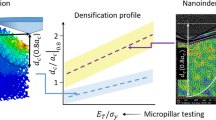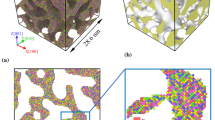Abstract
In this study, uniaxial tensile loading simulations were performed on several single crystalline copper nanoporous (NP) structures with varying relative density (RD) via molecular dynamics simulations. From the results, two distinctive deformation patterns were observed: structures with a low RD went through coarsening, and structures with a high RD did not. During coarsening, dislocations are nucleated because of the high surface stress induced by the thin ligaments. These dislocations drive the merging of ligaments as well as nodes and lead to an increase in the differences between the size of nodes and ligaments. The disproportional nodes and ligaments result in a lowered strength. In addition, larger nodes provide more favorable circumstances for the formation of sessile dislocations, which hinder the movement of other propagating Shockley partials and result in strain hardening. Subsequently, lower RD structures offer anomalously high strain-hardening potential, whereas high RD structures show better strength but poor deformability. These results help us in better understanding the plastic behavior of NP structures as a function of their RD.








Similar content being viewed by others
References
Q. Bai, C. Si, J. Zhang, and Z. Zhang: Sign inversion of surface stress-charge response of bulk nanoporous nickel actuators with different surface states. Phys. Chem. Chem. Phys. 18, 19798 (2016).
K. Hu, D. Lan, X. Li, and S. Zhang: Electrochemical DNA biosensor based on nanoporous gold electrode and multifunctional encoded DNA–Au bio bar codes. Anal. Chem. 80, 9124 (2008).
J. Biener, A. Wittstock, L.A. Zepeda-Ruiz, M.M. Biener, V. Zielasek, D. Kramer, R.N. Viswanath, J. Weissmuller, M. Baumer, and A.V. Hamza: Surface-chemistry-driven actuation in nanoporous gold. Nat. Mater. 8, 47 (2009).
M.M. Biener, J. Biener, A. Wichmann, A. Wittstock, T.F. Baumann, M. Bäumer, and A.V. Hamza: ALD functionalized nanoporous gold: Thermal stability, mechanical properties, and catalytic activity. Nano Lett. 11, 3085 (2011).
E. Seker, M.L. Reed, and M.R. Begley: Nanoporous gold: Fabrication, characterization, and applications. Materials 2, 2188 (2009).
B.N.D. Ngo, A. Stukowski, N. Mameka, J. Markmann, K. Albe, and J. Weissmuller: Anomalous compliance and early yielding of nanoporous gold. Acta Mater. 93, 144 (2015).
T. Fujita, P. Guan, K. McKenna, X. Lang, A. Hirata, L. Zhang, T. Tokunaga, S. Arai, Y. Yamamoto, N. Tanaka, Y. Ishikawa, N. Asao, Y. Yamamoto, J. Erlebacher, and M. Chen: Atomic origins of the high catalytic activity of nanoporous gold. Nat. Mater. 11, 775 (2012).
N. Badwe, X. Chen, and K. Sieradzki: Mechanical properties of nanoporous gold in tension. Acta Mater. 129, 251 (2017).
N.J. Briot and T.J. Balk: Developing scaling relations for the yield strength of nanoporous gold. Philos. Mag. 95, 2955 (2015).
C.J. Ruestes, D. Schwen, E.N. Millán, E. Aparicio, and E.M. Bringa: Mechanical properties of Au foams under nanoindentation. Comput. Mater. Sci. 147, 154 (2018).
A.C. To, J. Tao, M. Kirca, and L. Schalk: Ligament and joint sizes govern softening in nanoporous aluminum. Appl. Phys. Lett. 98, 051903 (2011).
L. He and N. Abdolrahim: Deformation mechanisms and ductility enhancement in core–shell Cu@Ni nanoporous metals. Comput. Mater. Sci. 150, 397 (2018).
N. Abdolrahim, D.F. Bahr, B. Revard, C. Reilly, J. Ye, T.J. Balk, and H.M. Zbib: The mechanical response of core–shell structures for nanoporous metallic materials. Philos. Mag. 93, 736 (2013).
A. Neogi, L. He, and N. Abdolrahim: Atomistic simulations of shock compression of single crystal and core–shell Cu@Ni nanoporous metals. J. Appl. Phys. 126, 015901 (2019).
N. Abdolrahim, I.N. Mastorakos, S. Shao, D.F. Bahr, and H.M. Zbib: The effect of interfacial imperfections on plastic deformation in nanoscale metallic multilayer composites. Comput. Mater. Sci. 86, 118 (2014).
A. Mathur and J. Erlebacher: Size dependence of effective Young's modulus of nanoporous gold. Appl. Phys. Lett. 90, 061910 (2007).
X.Y. Sun, G.K. Xu, X.Y. Li, X.Q. Feng, and H.J. Gao: Mechanical properties and scaling laws of nanoporous gold. J. Appl. Phys. 113, 023505 (2013).
H. Liu and N. Abdolrahim: A modified scaling law for stiffness of nanoporous materials based on gyroid cell model. Int. J. Mech. Sci. 166, 105223 (2019).
K.R. Mangipudi, E. Epler, and C.A. Volkert: Topology-dependent scaling laws for the stiffness and strength of nanoporous gold. Acta Mater. 119, 115 (2016).
N. Huber, R.N. Viswanath, N. Mameka, J. Markmann, and J. Weißmüller: Scaling laws of nanoporous metals under uniaxial compression. Acta Mater. 67, 252 (2014).
D.A. Crowson, D. Farkas, and S.G. Corcoran: Mechanical stability of nanoporous metals with small ligament sizes. Scr. Mater. 61, 497 (2009).
Q. Li, L. Guo, T. Qiu, J. Ye, L. He, X. Li, and X. Tuo: Polyurethane/polyphenylsilsequiloxane nanocomposite: From waterborne dispersions to coating films. Prog. Org. Coat. 122, 19 (2018).
W.X. Zhang and T.J. Wang: Effect of surface energy on the yield strength of nanoporous materials. Appl. Phys. Lett. 90, 063104 (2007).
N. Beets, D. Farkas, and S. Corcoran: Deformation mechanisms and scaling relations in the mechanical response of nano-porous Au. Acta Mater. 165, 626 (2019).
Y. Cui, B. Derby, N. Li, N.A. Mara, and A. Misra: Suppression of shear banding in high-strength Cu/Mo nanocomposites with hierarchical bicontinuous intertwined structures. Mater. Res. Lett. 6, 184 (2018).
T. Zhu, J. Li, A. Samanta, H.G. Kim, and S. Suresh: Interfacial plasticity governs strain rate sensitivity and ductility in nanostructured metals. Proc. Natl. Acad. Sci. 104, 3031 (2007).
N. Beets and D. Farkas: Mechanical response of Au foams of varying porosity from atomistic simulations. JOM 70, 2185 (2018).
Y-c.K. Chen-Wiegart, S. Wang, Y.S. Chu, W. Liu, I. McNulty, P.W. Voorhees, and D.C. Dunand: Structural evolution of nanoporous gold during thermal coarsening. Acta Mater. 60, 4972 (2012).
R. Liu and A. Antoniou: A relationship between the geometrical structure of a nanoporous metal foam and its modulus. Acta Mater. 61, 2390 (2013).
G. Pia and F. Delogu: Coarsening of nanoporous Au: Relationship between structure and mechanical properties. Acta Mater. 99, 29 (2015).
K. Kolluri and M.J. Demkowicz: Coarsening by network restructuring in model nanoporous gold. Acta Mater. 59, 7645 (2011).
H-J. Jin, L. Kurmanaeva, J. Schmauch, H. Rösner, Y. Ivanisenko, and J. Weissmüller: Deforming nanoporous metal: Role of lattice coherency. Acta Mater. 57, 2665 (2009).
R.N. Viswanath, V.A. Chirayath, R. Rajaraman, G. Amarendra, and C.S. Sundar: Ligament coarsening in nanoporous gold: Insights from positron annihilation study. Appl. Phys. Lett. 102, 253101 (2013).
S. Parida, D. Kramer, C.A. Volkert, H. Rosner, J. Erlebacher, and J. Weissmuller: Volume change during the formation of nanoporous gold by dealloying. Phys. Rev. Lett. 97, 035504 (2006).
A.A. El-Zoka, J.Y. Howe, R.C. Newman, and D.D. Perovic: In situ STEM/SEM study of the coarsening of nanoporous gold. Acta Mater. 162, 67 (2019).
S. Plimpton: Fast parallel algorithms for short-range molecular dynamics. J. Comput. Phys. 117, 1 (1995).
J.W. Wilkerson: Anomalous size effects in nanoporous materials induced by high surface energies. J. Mater. Res. 34, 2337 (2019).
Y. Li, B-N. Dinh Ngô, J. Markmann, and J. Weissmüller: Topology evolution during coarsening of nanoscale metal network structures. Phys. Rev. Mater. 3, 076001 (2019).
H. Liu, L. He, and N. Abdolrahim: Molecular dynamics simulation studies on mechanical properties of standalone ligaments and networking nodes, a connection to nanoporous material. Model. Simulat. Mater. Sci. Eng. 26, 075001 (2018).
L. He and N. Abdolrahim: Stress-assisted structural phase transformation enhances ductility in Mo/Cu bicontinuous intertwined composites. ACS Appl. Nano Mater. 2, 1890 (2019).
N. Abdolrahim, I.N. Mastorakos, and H.M. Zbib: Deformation mechanisms and pseudoelastic behaviors in trilayer composite metal nanowires. Phys. Rev. B 81, 054117, (2010).
A.F. Voter and S.P. Chan: Accurate Interatomic Potentials for Ni, Al and Ni3Al. MRS Proceedings, Vol. 82, 175, (1986).
M.S. Daw and M.I. Baskes: Embedded-atom method: Derivation and application to impurities, surfaces, and other defects in metals. Phys. Rev. B 29, 6443 (1984).
A. Cao and Y.Wei: Atomistic simulations of the mechanical behavior of fivefold twinned nanowires. Phys. Rev. B 74, 214108 (2006).
S. Alexander and A. Karsten: Extracting dislocations and non-dislocation crystal defects from atomistic simulation data. Model. Simulat. Mater. Sci. Eng. 18, 085001 (2010).
S. Alexander: Visualization and analysis of atomistic simulation data with OVITO–the open visualization tool. Model. Simulat. Mater. Sci. Eng. 18, 015012 (2010).
R. Kimmel, N. Kiryati, and A.M. Bruckstein: Sub-pixel distance maps and weighted distance transforms. J. Math. Imag. Vis. 6, 223 (1996).
C.R. Maurer, Q. Rensheng, and V. Raghavan: A linear time algorithm for computing exact euclidean distance transforms of binary images in arbitrary dimensions. IEEE Trans. Pattern Anal. Mach. Intell. 25, 265 (2003).
P. Soille: Morphological Image Analysis: Principles and Applications, 2nd ed. (Springer, 2003); pp. 170–171.
Acknowledgments
This study was conducted by the support of the National Science Foundation (Grant No. 1609587). Computational resources are provided by the Center for Integrated Research Computing at the University of Rochester, and Extreme Science and Engineering Discovery Environment (Grant No. MSS180001).
Author information
Authors and Affiliations
Corresponding author
Supplementary material
Supplementary material
To view supplementary material for this article, please visit https://doi.org/10.1557/jmr.2020.68.
Rights and permissions
About this article
Cite this article
He, L., Hadi, M., Liu, H. et al. Mechanism of coarsening and deformation behavior of nanoporous Cu with varying relative density. Journal of Materials Research 35, 2620–2628 (2020). https://doi.org/10.1557/jmr.2020.68
Received:
Accepted:
Published:
Issue Date:
DOI: https://doi.org/10.1557/jmr.2020.68




